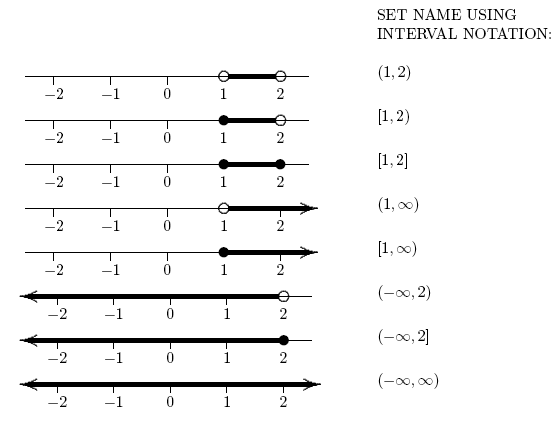 Introduction to Sets
Introduction to Sets
Examples
Notes About Sets
- A set is a mathematical expression.
- Sets can have different names!
If a set has $\,n\,$ members, where $\,n\,$ is a whole number, then it is called a finite set (pronounced with a long i, FIGH-night).
If a set is not finite, then it is infinite (pronounced with a short i, IN-fi-nit).
Examples
Symbols Used in Connection with Sets
The following symbols are used in connection with sets:
- $\cssId{s50}{\{}\;\;\cssId{s51}{\}}\;$ are called braces. They are used in list notation for sets (see below).
- $\cssId{s54}{(}\;\;\cssId{s55}{)}\;$ are called parentheses. (Singular form is parenthesis.) They are used in interval notation for sets (see below).
- $\cssId{s59}{[}\;\;\cssId{s60}{]}\;$ are called brackets. They are used in interval notation for sets (see below).
List Notation for Sets
- List notation for sets is used whenever the elements of a set can be listed.
- Braces $\;\{\;\;\}\;$ are used for list notation.
- Separate members of the set with commas.
- Use three dots $\;\ldots\;$ to indicate that a pattern is to be repeated. Be sure to list enough elements to clearly establish the pattern.
- For a finite set, the order that elements are listed doesn't matter.
Examples
Membership in a Set
- The verb $\;\in\;$ is used to denote membership in a set.
- The sentence $\;x\in S\;$ is read as: ‘$\,x\,$ is in $\,S\;$’ or ‘$\,x\,$ is an element of $\,S\;$’ or ‘$\,x\,$ is a member of $\,S\;$’.
- The sentence $\;x\notin S\;$ is read as: ‘$\,x\,$ is not in $\,S\;$’ or ‘$\,x\,$ is not an element of $\,S\;$’ or ‘$\,x\,$ is not a member of $\,S\;$’.
Example
A Special Sentence
The sentence ‘ Let $\,S = \{1,2,3\}\,$’ is used to assign the name $\,S\,$ to the set $\,\{1,2,3\}\,.$ The word ‘let’ is the key!
Example
So, the empty set is empty! It has no members!
Be careful: the set $\,\{\emptyset\}\;$ is a set with one member—it is NOT the empty set.
Interval Notation
- Interval notation is used to describe intervals of real numbers.
- Intervals of real numbers are infinite sets.
- Parentheses $\;(\;\;)\;$ are used when an endpoint is not included.
- Brackets $\;[\;\;]\;$ are used when an endpoint is included.
- The ‘infinity’ symbol $\,\infty\,$ is used to denote that an interval extends forever to the right.
- The ‘negative infinity’ symbol $\,-\infty\,$ is used to denote that an interval extends forever to the left.
- The numbers used in interval notation always go from left to right on the number line.

Subsets
Roughly, a subcollection from a set is called a subset.
Example
Let $\,S = \{a,b\}\,.$ Then:
- $\,\{a\}\,$ is a subset (choose only the ‘$\,a\,$’ )
- $\,\{b\}\,$ is a subset (choose only the ‘$\,b\,$’ )
- $\,\{a,b\}\,$ is a subset (choose everything!)
- $\,\{\;\}\,$ is a subset (choose nothing!)
- $\,B\,$ is the set $\,S\,$ itself
- $\,B\,$ is the empty set
- each member of $\,B\,$ is also a member of $\,S\,$